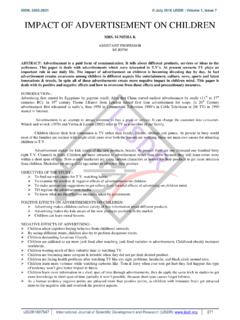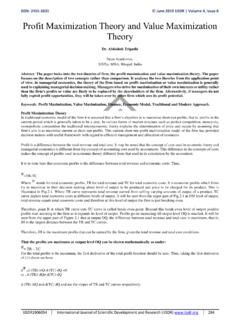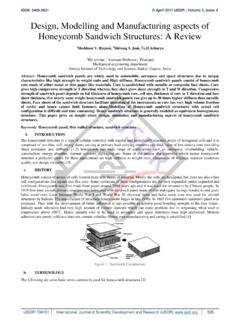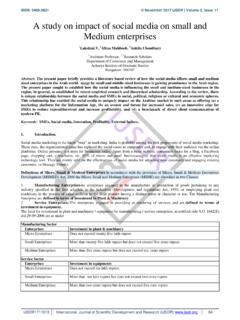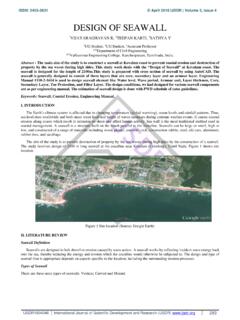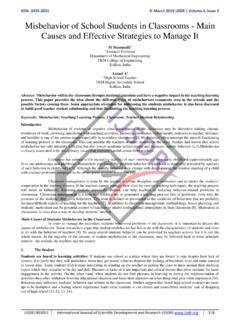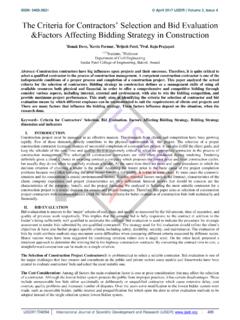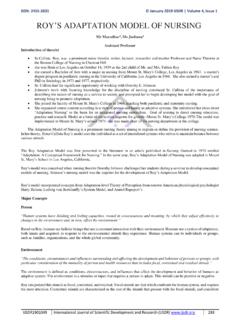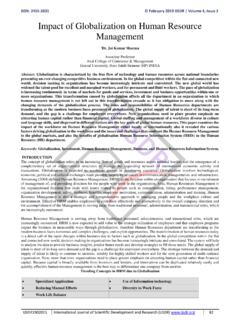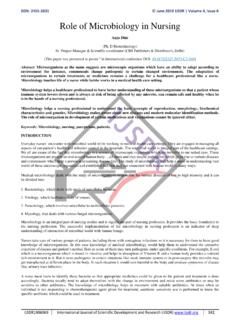Transcription of A REVIEW ON MULTIPLE USES OF BANANA PEEL - IJSDR
1 ISSN: 2455-2631 March 2020 IJSDR | Volume 5, Issue 3. A REVIEW ON MULTIPLE USES OF BANANA PEEL. Prashanthi D*, Chaitanya M. 1. Assistant Professor, 2 Professor & HoD. Quality Assurance Department Sree Siddaganga College of Pharmacy, Tumkur, India. Abstract: BANANA trees are giant perennial herbs coming from the Southeast Asia and belong to the Musa genus. From the botanical point of view, Musa genus can be divided into two parts: edible and wild species. It is widely believed there are more than 1,000 types of bananas in the world, which are subdivided into 50 groups. The scientific names of most cultivated bananas are Musa acuminata, Musa balbisiana, and Musa paradisiaca for the hybrid Musa acuminata M. balbisiana, depending on their genomic constitution. The present REVIEW discusses usefulness of BANANA peel in different fields. Keywords: Musa, perennial, genomic.
2 INTRODUCTION: BANANA is one of the world's leading fruit crops grown in over 122 countries worldwide. BANANA normally has a short shelf life and start deteriorating just after plucking. The most widely used part of BANANA is the flesh of the fruit; meanwhile, the outer skin is only used for animal feed and organic fertilizer. Plantain and unripe BANANA are cooked as vegetable, chips, snacks, powder etc., whereas, mature dessert BANANA is eaten raw. In recent times, BANANA peel has been utilized for various industrial applications including bio-fuel production, bio-sorbents, pulp and paper, cosmetics, energy related activities, organic fertilizer, environmental cleanup and biotechnology related processes. The BANANA peel is rich in phytochemical compounds than its pulp. The antifungal, antibiotic properties of BANANA peel can put to be good use.
3 The peel is used for home remedy for treating several skin problems including allergies and skin irritations. The BANANA peels waste is normally disposed in municipal landfills, which contributes to the existing environmental problems. However, the problem can be recovered by utilizing its high-added value compounds, including the dietary fibre fraction that has a great potential in the preparation of functional foods. 1. Natural wrapping paper with additive essential oils. BANANA peel waste contains more fine fibers than those that are made of wood with high cellulose (6065%), hemicellulose (6-8%). and lignin (5-10%). the cellulose in the BANANA peel is far higher than that in softwood, conventional raw material of the paper. Moreover, BANANA peel only contains lignin (5-10%) that makes the cellulose separation process easier. Thus, the BANANA peel is potentially used to be the raw material of papermaking to reduce the dependence of wood as the raw material of wrapping paper.
4 The use of BANANA peel waste also increases the optimization of the waste itself by increasing the economic value. Additive materials in the form of essential oils are added as a preservative and aroma agent, namely cinnamon oil, lemon oil, clove oil and lime oil respectively 2% and 3%1. 2. antibacterial and phytochemical analysis of BANANA peel. The invitro antibacterial activity of ethanolic and aqueous extract of BANANA (Musa sapientum) peels was investigated on both gram- positive and gram-negative bacteria using agar well diffusion technique. phytochemical result showed ethanol to be a better solvent for the extraction of the bioactive agents in BANANA peels which include: glycosides, alkaloids, saponins, tannins, flavonoids and volatile oil. The presence of glycosides and alkaloids in Musa sapientum peels may be attributed to their use by traditional medicine practitioners in healthcare systems in the treatment of some bacterial infections such as cough, fever, cold and venereal diseases.
5 Thus extracts from the peel can be used to control infections caused by Salmonella typhi, Escherichia coli, Klebsiella pneumoniae and Staphylococcus aureus. Infections such as bronchopneumonia, bacterial endocarditis and meningitis caused by Micrococcus Spp. and Pseudomonas aeruginosa will also find treatment with the extracts of this medicinal peel. Thus the use of BANANA peel by traditional medical practitioners is justified2. 3. Dietary Administration of BANANA (Musa acuminata) Peel Flour Affects the Growth, Antioxidant Status, Cytokine Responses, and Disease Susceptibility of Rohu, Labeo rohita. To explore the feasibility of Musa acuminate ( BANANA ) peels as a feed additive, effects of BANANA peel flour (BPF) on the growth and immune functions of Labeo rohita were evaluated. Diets containing five different concentrations of BPF (0% [basal diet], 1%[B1], 3%[B3], 5%[B5], and 7%[B7]) were fed to the fish ( ) for final weight gain and specific growth rate were higher ( < ) in the B5 group.
6 These results suggest that dietary BPF at 5% could promote growth performance and strengthen immunity in 4. GC-MS analysis of bioactive components from BANANA peel (Musa sapientum peel). The possible bioactive components from ethanolic extract of BANANA peel using gas chromatography-mass spectrometry (GC-MS). were determined. Eight compounds were identified which included estragole ( ), hexadecanoic acid ethyl ester ( ), IJSDR2003024 International Journal of Scientific Development and Research ( IJSDR ) 120. ISSN: 2455-2631 March 2020 IJSDR | Volume 5, Issue 3. epicatechin ( ), gallocatechin ( ), p-coumaric acid ethyl ester( ) , 1,2 benzenedicarboxylic acid mono (2-ethylhexyl). ester ( ) , beta-tocopherol ( ) and vitamin E ( ). 5. The effects of BANANA peel preparations on the properties of BANANA peel dietary fibre concentrate. Four different preparation methods of BANANA peel, dry milling, wet milling, wet milling and tap water washing, and wet milling and hot water washing were investigated on their effects on the chemical composition and properties of the BANANA peel dietary fibre concentrate (BDFC).
7 The dry milling process gave the BDFC a significant higher fat, protein, and starch content than the wet milling process, resulting in a lower water holding capacity (WHC) and oil holding capacity (OHC). Washing after wet milling could enhance the concentration of total dietary fibre by improving the removal of protein and fat. Washing with hot water after wet milling process caused a higher loss of soluble fibre fraction, resulting in a lower WHC and OHC of the obtained BDFC when compared to washing with tap water. Wet milling and tap water washing gave the BDFC the highest concentration of total and soluble dietary fibre, WHC and OHC. 6. Identification of phenolic compounds from BANANA peel (Musa paradaisica L.) as antioxidant and antimicrobial agents. The efficiency of the different solvent systems: aqueous, 80 % methanol, 80% ethanol and 80% acetone was used for extraction of phenolic, flavonoid and tannin compounds.
8 For mineral content, potassium is the major element found in BANANA peel was ( %. of DW) followed by magnesium, calcium, sodium and phosphorus were ( , , and % of DW), respectively. Also, the content of microelement including iron, manganese, zinc and copper were , , and ppm, respectively. Methanolic extract (80%) had the highest content of total phenolic, flavonoid and tannin were , and mg /g DW. respectively. Most of acetone BANANA peel extracts (80%) was found to be highest antioxidant and antimicrobial activity at 600 ppm against gram positive and negative bacteria, fungi and yeast. The phenolic profiles of BANANA peel acetone extract was identified by HPLC. The main phenolic compounds were chyrsin, qurectein and catchin. These results clearly encourage the application of BANANA peel as a potent natural source of antioxidant and antimicrobial sources.
9 7. analysis of properties of concrete using dried BANANA peel powder as admixture. Ingredients other than cement, water & aggregates that import a specific quality to either plastic (fresh) mix or the hardened concrete (ASTMC 496) is called concrete admixture. The flexural strength of concrete by using BANANA peel powder as admixture has increased, but considerable lesser compressive strength has increased. The percentage of transmission temperature and reduction time of temperature has decreased; hence it is clear that the exothermal reaction in concrete has been reduced by using dried BANANA peel powder as admixture. 8. Nutrient and Heavy Metal Composition of BANANA (Musa paradisiaca) Peels. The higher amounts of K than Na in the peel samples investigated are considered of comparative advantage. This is because intake of diets with higher Na to K ratio has been related to the incidence of hypertension.
10 Phosphorus is involved in several biological processes such as: bone mineralization, energy production, cell signaling and regulation of acid-base homeostasis. Findings from this study indicate that unripe plantain peel contains higher quantities of Zn than ripe plantain peel, unripe and ripe BANANA peels respectively. The considerable amount of Fe in unripe plantain peel is an important finding in this study. Iron is an essential component of hemoglobin and it is critical to the proper function of the immune system and the production of energy. 9. Comparative nutritional, functional, morphological, and diffractogram study on culinary BANANA (Musa ABB) peel at various stages of development. The culinary BANANA peel, which is an agricultural waste available in abundance, has not been able to draw much attention in terms of its utilization.
